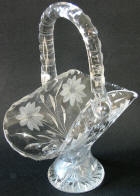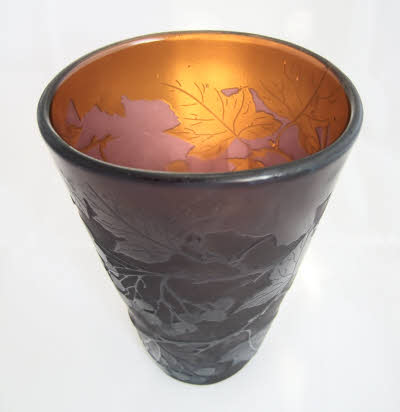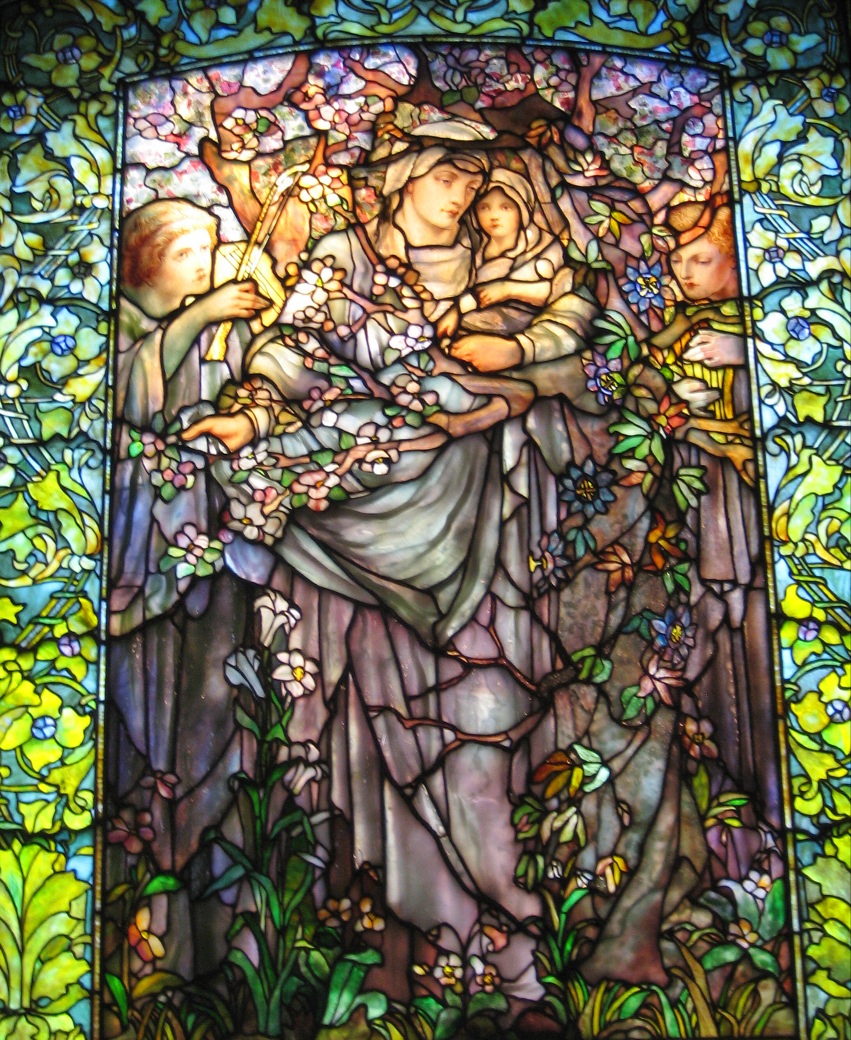A Sugar and Creamer Signed “Dingwall”
This small sugar and creamer set (circa 1905) is cut in a simple hobstar pattern. It is comparable to the best American brilliant period glass. It is signed by Dingwall, an agent for the Gundy-Clapperton company.
A Leaf Shaped Nappy Signed “Gundy-Clapperton”
This leaf shaped “nappy” (or candy dish) is marked with the post-1920 version of the Gundy-Clapperton Signature (the letter “C” inside a shamrock). It illustrates that Canadian companies continued to cut purely geometric designs long after most American firms had discontinued the practice. This is a mediocre quality piece that has a few chips, however, the interesting shape gives it a moderate value.

A Leaf Shaped Nappy Signed “Gundy-Clapperton”This leaf shaped “nappy” (or candy dish) is marked with the post-1920 version of the Gundy-Clapperton Signature(the letter “C” inside a shamrock). It illustrates that Canadian companies continued to cut purely geometricdesigns long after most American firms had discontinued the practice. This is a mediocre quality piecethat has a few chips, however, the interesting shape gives it a moderate value.(retail value: $60)
Many antique glass enthusiasts are familiar with the “American Brilliant Period” (ABP) of cut and engraved glass. The period lasted from approximately 1880 to 1920. It was part of an extravagant style of decorative arts introduced by Victorian era millionaires. These individuals were eager to demonstrate their wealth and power by acquiring and displaying a variety of spectacular objects. Collectors of this glass are no doubt familiar with names like Dorflinger, Libbey, Hawkes, Hoare and Clark. These firms produced some of the finest cut and engraved glass in history. However, few collectors know much about companies like Gundy-Clapperton, Roden Brothers, Gowans-Kent and the House of Birks. These Canadian firms produced or distributed glassware that rivalled the products. Canadian Brilliant Period products are also worthwhile collectables.
Prominent Canadian Brilliant Cut Glass Companies
There are four prominent producers and distributors of CBP glass that the collector should be aware of. Unlike some American firms (like Libbey, Dorflinger and Hawkes), Canadian firms did not manufacture their own blanks: they imported blanks from the United States and Europe. Canadian glass patterns tend to closely resemble those cut by American companies, although, because most Canadian firms were founded later than American firms, they tended to be slightly “behind the times”. For instance, most American firms stopped cutting geometric designs by 1910; however, some Canadian companies continued to do so well into the 1920’s.
This small hobstar and fan pattern dish (circa 1915) is signed by the House of Birks. It is acid polished and cut on a mediocre quality blank.
The Gundy-Clapperton Company
This is the most well known Canadian firm. It was founded in 1905 by C.H. Clapperton, a glass cutter who had previously worked for the Libbey Glass Company in Toledo, Ohio.
Clapperton was joined by N.F. Gundy approximately one year later. The Gundy-Clapperton company operated in Toronto from 1905 until 1931. Pieces made by this company were usually signed with a shamrock containing either “G, C and Co” (prior to 1920) or simply “C”. The words “DINGWALL”, “G B ALLEN VANCOUVER” or “Birks” (inside a diamond) sometimes accompany the company mark. Gundy-Clapperton made both geometric pieces (which frequently resembled Libbey products) and high quality “intaglio” pieces. There is evidence that this company continued to hand polish some of their products as late as 1913, by which time most American firms had switched to the cheaper, but less effective, acid polishing technique.
This hobstar and fan bowl is signed by the maker and dates circa 1905. The glass and the cutting are both high quality. It has a sizable chip on the left side which reduces its value by about 50%.
The Roden Brothers Company
This firm was founded in Montreal in 1879 as a jewellery and silversmith company. Around the year 1900, they opened glass cutting shops in Toronto and London. Early Roden Brothers objects were signed “Port & Markle” (inside a circle) while later items were marked with a gothic style “R” flanked by two lions. This company made both high quality geometric pieces and mediocre quality floral pieces.
The Gowans-Kent Company
There is not much information about this Toronto based firm; although it appears that it was founded just prior to the turn of the 20th Century. Gowans-Kent pieces were marked with the word “Elite” inside a Maple Leaf and Circle. The quality of the glass appears to be
excellent on all of their pieces both purely geometric and floral-geometric items.
This small dish (circa 1900) is signed with word “Elite” inside an encircled maple leaf.
It is decorated with a simple hobstar and fan pattern but it is hand polished and cut on a high quality blank.
The House of Birks
The House of Birks did not manufacture brilliant period glass. However, the word “Birks” (inside a diamond) appears on many CBP items (either by itself or in combination with signatures used by the other companies). The House of Birks was a jewellery company that distributed CBP glass in the late 19th and early 20th centuries. As such, it was much like the American distributor, C.G. Alford and Company, which used a similar signature (the word “Alford” inside a diamond).
The simple floral decorations on this piece suggest that it dates from the late brilliant period (circa 1920).
Bridal baskets are a relatively uncommon item. Moreover, the basket is signed and is in excellent condition, These features give it a substantial value.
by Christopher and Marie Kierkus
















